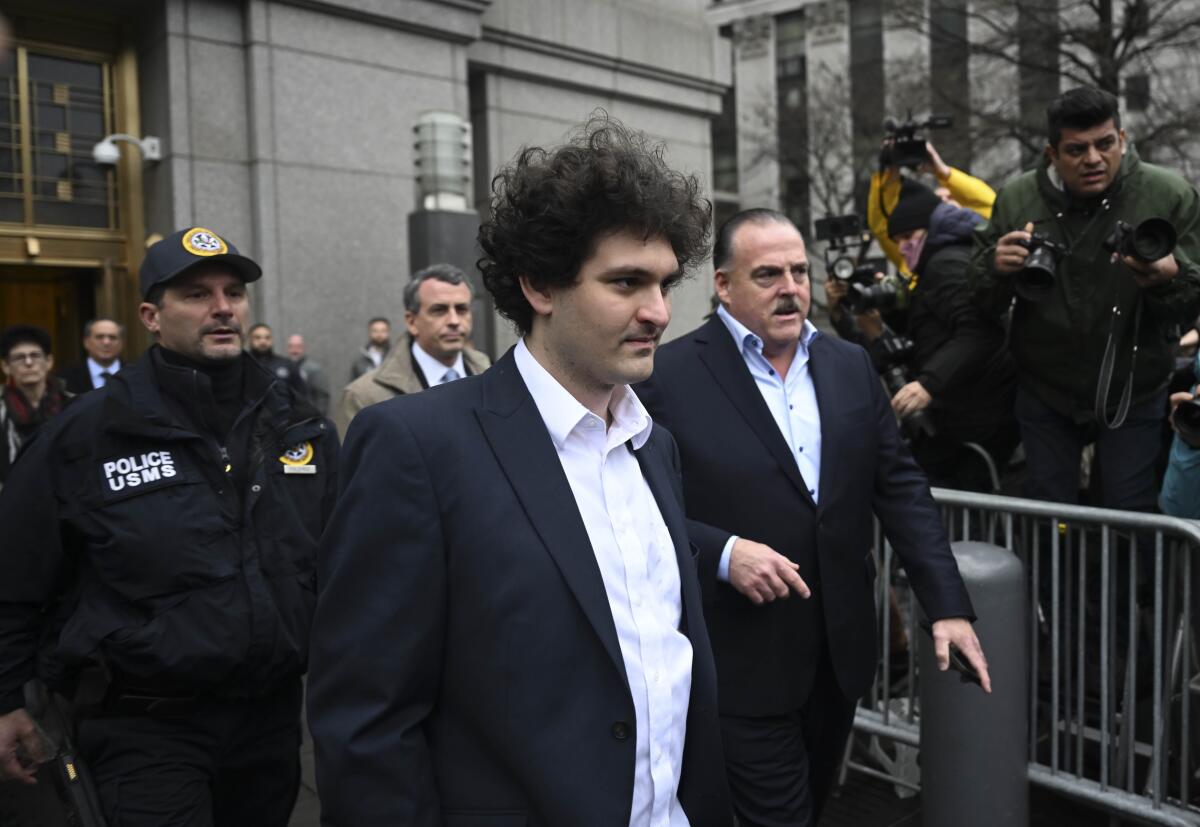Sam Bankman-Fried’s parents used their house to bail him out. But they rent the land from Stanford

- Share via
Shortly before Christmas, FTX founder Samuel Bankman-Fried, indicted on federal charges of fraud and money laundering, was released on a $250-million bail bond that was secured by his parents’ Palo Alto-area home.
The size of the bail bond — 25 times bigger than Bernie Madoff’s — garnered considerable attention. The prosecution termed it “the largest ever pretrial bond.” What hasn’t drawn notice is the fact that Joseph Bankman and Barbara Fried, who are professors at Stanford Law School, are not typical homeowners. Their property is a faculty home on the Stanford campus itself. Stanford owns the land, and Bankman and Fried lease it.
Although the couple told the court that the five-bedroom, 3,000-square-foot home is worth $3.55 million, the restrictions that come with owning a home on Stanford property make it difficult to gauge its market value via conventional means. Were Bankman and Fried ever to sell their house — or were the government to take possession of it, in the event of a bail violation, and then have to sell it — the pool of potential buyers would be limited to other eligible Stanford faculty. Whatever the scenario, a sale would have to go through Stanford.
It’s a curious circumstance that underscores the wide latitude granted in bail proceedings to wealthy, white defendants, in sharp contrast to the unforgiving terms that often keep poor people of color behind bars while they await trial.
“Prosecutors treat these white-collar cases totally differently than other cases,” said Alison Siegler, a University of Chicago Law School professor. “There’s a lack of equity in all of this.”
While using a Stanford faculty home to secure bail may be unusual, the arrangement is perfectly legal. Likewise, there is nothing unorthodox in the size of a bail bond greatly exceeding the value of the assets used to secure it. The $250-million figure ascribed to Bankman-Fried’s bond, experts said, was essentially just an arbitrary number.
“The goal is really for the parents to do everything possible to put themselves on the line,” said Columbia University Law School professor Daniel Richman. Putting up the family home for bail is a way to secure the commitment of people close to Bankman-Fried who will help make sure he doesn’t flee, said Richman, a former federal prosecutor. “It’s almost symbolic in the sense that they’re taking their most valuable asset and pledging it.”
Stanford has more than 800 on-campus faculty homes. Only Stanford faculty members can buy them.
University publications explain faculty homes this way: Stanford faculty may “purchase a leasehold interest.” Buyers sign a “ground lease” with the university, and then faculty members pay rent to Stanford and are responsible for paying all property taxes.
The arrangement is so complicated and arcane that the Santa Clara County assessor has an entire page devoted to Stanford faculty housing.
The cryptocurrency billionaire employed several former regulators who aided his efforts to woo top CFTC officials, emails obtained by the Los Angeles Times show.
This unique structure dates to the university’s founding by Leland and Jane Stanford.
“Because the Founding Grant stipulates that campus land cannot be sold, those who buy a house on campus only lease the land beneath it,” explained Stanford Magazine. According to the 2005 article, author David Leavitt grew up in the same house as Bankman-Fried and wrote a novel inspired by the “inheritance quandary” of on-campus faculty housing.
A Stanford faculty housing brochure explains, “The Stanfords’ intention was to ensure that the land endowment to the University would exist in perpetuity.”
The goal of campus housing, the brochure notes, is “fostering an academic community in residence.”
As with many universities, faculty housing plays prominently in Stanford’s recruitment efforts. Prospective faculty members face a move to Palo Alto, where the average home price is $3.5 million, according to Zillow. Current Stanford faculty homes for sale include a four-bedroom, three-bathroom property for $1,962,500 and a two-bedroom, two-bathroom property for $870,000.
“No one could afford a house in Palo Alto but for these arrangements,” said Richman, the Columbia professor. “Stanford, as part of its effort to lure them, gives them a perk of the job.”
Bankman and Fried signed their 51-year lease with Stanford in 1991. A source familiar with the bail arrangement said that Bankman and Fried made the school aware of the use of the house as collateral.
A representative for Stanford said the university’s permission was not needed to use the house for bail.
“Under the terms of their ground lease with the university, Joseph Bankman and Barbara Fried have the right to use their leasehold interest as collateral for the bond, just as they can encumber their leasehold interest with a mortgage. Neither situation requires approval from the university,” Dee Mostofi, assistant vice president for external communications, said in a statement. “Accordingly, the university did not give approval for Joseph Bankman and Barbara Fried to use their leasehold interest as collateral for the bond as no approval was required under their ground lease.”
Stanford did not respond to a request for a copy of the lease agreement.
A representative for Bankman-Fried declined to comment.
Under federal law, defendants are presumed innocent, and pretrial release is supposed to be the standard. But in practice, the vast majority do not go home to their families. In 2019, 75% of federal defendants were detained awaiting their trials, according to data from the federal courts.
In “Freedom Denied,” a recent report led by Siegler, the University of Chicago professor, court watchers found that judges were routinely unlawfully jailing poor people and imposing excessive financial conditions, with people of color significantly more likely to be jailed unlawfully on cash bails that they could not afford.

Under the federal Bail Reform Act of 1984, jailing people before a trial is supposed to be the exception, used only to ensure community safety and that defendants appear in court. But in the decades since, pretrial detention rates have skyrocketed.
Siegler points to what she terms a “culture of detention” in which prosecutors ask for pretrial detention as a matter of course, and judges grant it without question, according to her research.
But, in the Bankman-Fried bail hearing, Siegler noted that the prosecution took a very different approach. The government said that Bankman-Fried had agreed to extradition from the Bahamas and had “family and community ties” and that risk to the community wasn’t a concern.
“This is an insane transcript to read because the argument the government is making is typically the kind of argument the defense would be making,” Siegler said. “Here, the prosecution is advocating to the judge to let this guy out pending trial. Usually, they’re advocating just the opposite.”
From the transcript, Siegler noted that it appeared that Bankman-Fried’s lawyers probably negotiated with the government to agree to extradition in exchange for pretrial release in a bail package.
Early on Monday, Sam Bankman-Fried made a bold prediction: “I don’t think I will be arrested.” Hours later, he was in custody.
In addition to the family home, Bankman-Fried’s bail package included hard cash: Two people whose names are under seal paid $500,000 and $200,000, respectively, to secure his release.
Whereas Bankman-Fried had a legal team to handle high-level bail negotiations, by comparison, more than 90% of federal defendants can’t afford an attorney, according to a 2017 judicial report. Additionally, more than a quarter of the nation’s district courts do not ensure that people are represented at their first court appearance, according to “Freedom Denied.”
Bankman-Fried’s trial is to begin in October. Meanwhile, the terms of his bail require, among other things, that he surrender his passport, wear an electronic monitoring device and remain at his parents’ home. A far cry from federal detention, he will be confined to a five-bedroom, three-bathroom house that is just over 3,000 square feet on nearly an acre lot with a pool and a hot tub, records show.
Bankman-Fried’s bail agreement is similar to — if not more restrictive than — that of Madoff, the financier who was accused of operating a $50-billion Ponzi scheme and received a 150-year sentence after being convicted of fraud and other crimes. Released on bail, Madoff had a nightly curfew but was free to travel during the day throughout Connecticut, southern New York and Long Island, according to the New York Times. Madoff secured his release using homes that were in his wife’s name.
If Bankman-Fried were to flee, the government could take his parents’ house. “What they’d be getting is ownership of the house. And not of the land,” said Richman, the Columbia professor. The government would then have to work with Stanford to sell the house to a buyer who met Stanford’s eligibility criteria, Richman said.
In a Jan. 4 filing, Bankman and Fried told the court that the equity interest in their home was $3.55 million, and they guaranteed that they would personally pay that amount if their son violated the terms of his bond.
Currently, more than 100,000 people remain in federal detention awaiting trial. According to Department of Justice data, 99% of people charged with a federal crime and released pretrial show up in court, and 98% do not commit crimes.
“It’s so rare that anybody doesn’t comply with these conditions when they’re given the chance to be released and go back to their family,” Siegler said.
Bankman-Fried, in the words of prosecutors, “perpetrated a fraud of epic proportions, stealing billions of dollars.”
“If we’re comfortable releasing somebody accused of a crime of this magnitude,” Siegler said, “that should really make us question why we’re locking so many people in jail pending trial who are accused of far less serious crimes.”
Times staff writer Adam Elmahrek contributed to this report.
More to Read
Inside the business of entertainment
The Wide Shot brings you news, analysis and insights on everything from streaming wars to production — and what it all means for the future.
You may occasionally receive promotional content from the Los Angeles Times.












